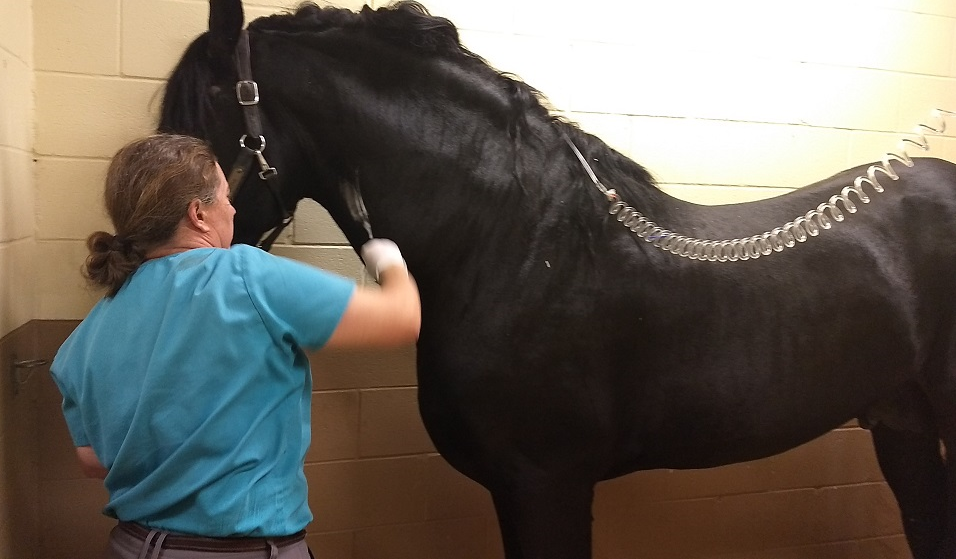Tuesdays with Tony
Colic vs COLIC, and the Cost
If I’ve learned anything from my years here at the Clinic, it’s that there’s colic, and then there’s COLIC. The colic kind of colic means some Banamine, some water and electrolytes, and, gasp, a whole lot less food over the next couple days. The COLIC kind of colic means one of two things: a whole bunch of fluids through an IV catheter, or surgery, or, even worse, both. The other difference: how much they cost. Being the wise and wonderful cat I am, I’m going to share with you all I learned about horse insurance the other night so that you can be prepared for the serious amounts of money COLIC can cost.
There are three different price brackets when talking about colic treatment. For the simple colic that just needs some drugs and some fluids, you can expect it to run somewhere in the $400 – $600 range. These things usually happen after hours, so there’s an emergency fee in there (unless you are on a Springhill Equine Wellness Plan!). If it’s a medical colic that doesn’t require surgery, but needs to come stay at the clinic for a few days, you’re looking at $800 – $2,000, depending on all kinds of things. This will include oversight by Yours Truly, so there’s that. For surgical colic, there is a very wide range of cost, because there’s a very wide range of surgeries, depending on what’s wrong. You can expect it to be somewhere between $7,500 – $15,000. I know, I know. I’ve napped on cars that were cheaper than that, too. So, let’s talk about insurance.

I can’t afford horse insurance
I’ll admit, I thought horse insurance was a whole lot of money. However, I learned from Rhonda Mack from Jerry Parks Insurance in Ocala, that for around $350 per year, a horse could have $11,000 of colic surgery coverage! That is a very reasonable number. But. Yep, I’m going to have a but here. This covers colic, but not much else. Keep reading for more insurance stuff, but know that there are very, very reasonable options to make sure you can help your horse.
How does insurance for horses work?
First, everyone decides on a value for your horse. No, you don’t just get to pick a number, any number. The value is based on purchase price (or stud fee if it’s a baby), training, show record, yada, yada, yada. Okay, we have a number. Now we start with a basic mortality policy. Everybody starts here. The premium on this policy is a percentage of that value number we came up with.
Now that you have mortality, you can add things like major medical or a medical assistance plan. Major medical will pay for just about anything your horse can do to themselves from colic to pneumonia to major lacerations to eye issues (and holy cow, can those get expensive fast!). Major medical will even help with diagnostics and treatments for lameness. More on the lameness stuff later. Or, for a more economical package, you can go with the assistance plan. It helps with colics, lacerations, etc., but not lameness. What does all this mean? You’ve got options when it comes to insurance!
One kicker to horse insurance is the pre-existing condition. If your horse has a problem with something, that thing gets excluded on future insurance policies. For example, your horse develops a left front lameness. My amazing Docs do their thing, and determine your horse has a lesion in the Suspensory ligament on that leg. Insurance will cover things this time around, but not after that.
Lameness and Insurance
If horses only got lame just after their insurance was renewed, we wouldn’t need to have this discussion. Horses don’t work that way, though. They like to go with “I’m going to go lame right before this insurance policy expires” plan. Great, you think. That horse I used as an example above with the Suspensory injury will be out for 6 months minimum. You won’t get to use all your insurance benefits because it happened 2 months before renewal. Never fear. In that scenario, the Suspensory will be covered for 3-4 months (depending on the insurer) of the new policy. But (I hate that word), it will be excluded after that and for all eternity going forward. Moral of the story here: have a talk with my Docs about lameness and insurance. It will help you make decisions.
What about ColiCare?
ColiCare, and a couple other similar programs, can be great ways to cover colic surgery! There’s a big but with them: they only cover surgery; not a medical colic. My Docs have the most experience with ColiCare, and they love it. SmartPak is easy to work with, and the payouts have been really quick and easy. My Docs are pretty “Meh” on the value of the supplement, but worth talking to them about it!
I know I can be a little bit snarky, but in all fairness to you humans, colic is tough. Heck, horse emergencies are tough. Insurance may be a way to help you handle those crazy emergencies a little better. Now I have to harass them about insuring me. There’s no way to put a value on all this amazingness, though, so that’s going to be tough.
Now be a good human. Scroll down a little further and subscribe to my blog. And if my blog isn’t enough to satiate your thirst for horse knowledge, check out the podcast the humans do called Straight From the Horse Doctor’s Mouth. You can get it on all the usual places, and I’ll admit, it’s pretty good, especially considering I’m not even on it. Imagine how awesome it would be if I was?

Tuesdays with Tony is the official blog of Tony the Clinic Cat at Springhill Equine Veterinary Clinic in Newberry, Florida. If you liked this blog, please subscribe below, and share it with your friends on social media! For more information, please call us at (352) 472-1620, visit our website at SpringhillEquine.com, or follow us on Facebook!
[jetpack_subscription_form title="Subscribe to Whinny's Wisdoms"]
